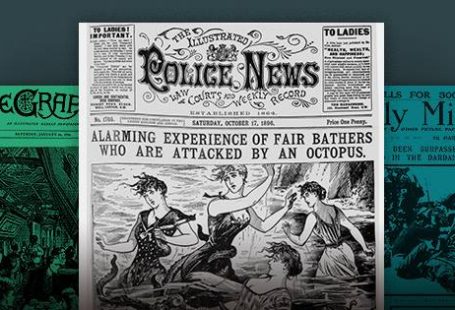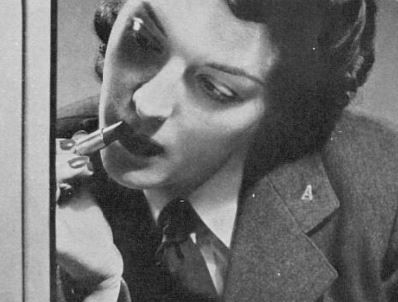On the first day of January 1753 maidservant Elizabeth Canning disappeared. She returned to her mother’s house some twenty-eight days later, emaciated and bedraggled, claiming that she had been held in a room against her will. As the case went to court, and her captors were arrested, many came to disbelieve Elizabeth Canning’s tale, resulting in Canning herself going on trial for perjury.
In 1754 the Manchester Mercury comments on the question of whether ‘Elizabeth Canning is or is not an Imposter,’ which is ‘still debated with great Warmth by her Advocates and Opponents’ a year after her supposed disappearance. To this day it is not known what really happened to Elizabeth Canning, but using contemporary accounts from the British Newspaper Archive’s wonderful collection of eighteenth century holdings, as well as later commentaries, we are going to take a look at this ‘tale of horror that stirred the country.’
Pearson’s Weekly | 28 September 1911
What is widely known about the first day of January 1753 is that Elizabeth Canning, who, according to Pearson’s Weekly nearly two centuries later, was ‘somewhat short of stature, with red and rather coarse features, and a dull expression of countenance,’ left her mother’s house in Aldermanbury, London, and went to visit her aunt and uncle. It was on her return, according to an article on mysterious abductions in the Nottinghamshire Guardian, 15 October 1880, that:
She was assaulted in Moorfields by two men, who robbed her of half a guinea, which was in a small box in her pocket, and three shillings that were loose. They also took her gown, apron, and hat, which one of them put into the pocket of his great coat, on which she screamed out; but he bound a handkerchief round her mouth, and tied her hands behind her, after which she received a violent blow to the head, which added to her former terror, occasioned her falling into a fit.
Canning reported that she was taken to a house, whereupon she was confronted by two girls and a woman, the woman later being identified as Mary Squires, a gypsy. Squires allegedly took Canning by the hand and asked if she wanted ‘to go their way,’ which Canning understood to mean prostitution. Canning refused, ‘on which Squires took a knife from a drawer, cut the lace from her stays, and took them from her. Then Squires pushed her up a few stairs out of the kitchen, to a place called the hay-loft, and shut the door on her.’
Britannia and Eve | 1 August 1947
Canning spent twenty-eight days in this attic, where she had ‘no food nor liquor,’ and clothed herself with items she found in the grate of a fireplace. During the afternoon of 29th January she was able to loosen a board that was nailed to the window and so make her escape.
Canning made her way to her mother’s house where she reported her ordeal. What is not in doubt is her physical state; certainly she had had very little to eat, as the Manchester Mercury reports:
She came home naked and emaciated, declaring, that she had received no sustenance during eight and twenty days but a few crusts and about a gallon of water… It was proven by the apothecary and physician who attended her, that her body was in such a condition as extream abstinence long continued would produce.
From Elizabeth’s accounts, it was established that she had been taken to the home of a woman named Susannah Wells. Mary Squires the gypsy was thrown into Newgate and faced execution. However, soon Canning’s ‘incredible’ story was put under scrutiny, some believing that it represented ‘a wild Dream, [rather] than a real Fact.’
Indeed, Susannah Wells, according to the Derby Mercury, ‘declared her Innocence, and that she had never seen Elizabeth Canning’ before. Virtue Hall, one of the girls who had been in the house when Canning arrived, retracted her confession against Mary Squires. And as for Mary Squires, many people were willing to prove that she had been far away from the Enfield crime scene:
And we hear that by Wednesday’s Post there arrived at the Lord Mayor’s Office nine Affidavits from Persons of Credit in Wiltshire, setting forth, that Mary Squires the Gipsey, under Sentence of Death in Newgate, was in that County at the Time of the Robbery and cruel Treatment of Elizabeth Canning; and that, if there should be Occasion, the Neighbourhood, from whence these nine came, is ready to send up many more.
But what would Elizabeth Canning’s motive be for such a falsehood – the ‘most blackest, most premeditated, and most audacious Perjury, levelled against the Lives of several innocent Persons?’ The Nottinghamshire Guardian in 1880 claims to have the answer – that unmarried Elizabeth Canning was pregnant, and had gone away to conceal the child, preferring to spread false accusations rather than reveal her shame.
Elizabeth Canning herself was subsequently put on trial, and it was left to a jury to decide her guilt. The crux of the case appeared to hang on the whereabouts of Mary Squires. Thirty-six witnesses claimed her to be in Abbotsbury, whilst twenty-six swore she was in Enfied.
In the end the jury came to the following decision:
The jury was of opinion that she was guilty of perjury; but supposing that though she had sworn falsely it was by mistake, they brought in their verdict in writing that she was guilty of perjury but that the perjury was not willful and corrupt.
Whether maliciously meant or not, Elizabeth Canning was found guilty of perjury and sentenced to seven years transportation. And whether her account was the truth or not, it made an indelible mark on the landscape of mid-eighteenth century society. It became a ‘Matter of real Concern,’ with her case dividing the public and authority figures alike. Justice of the Peace, Tom Jones author Henry Fielding was inclined to take Canning’s side, whilst the Mayor of London spearheaded the inquiry against her.
To a modern audience, Canning’s story plays out like any high profile trial enacted under the glare of the media. And it was the newspapers, like those in our archive, which helped to fan the fire of the sensation that her initial disappearance caused.
You can discover more contemporary accounts yourself by simply searching for ‘Elizabeth Canning,’ and limiting your search years to 1753 and 1754.








